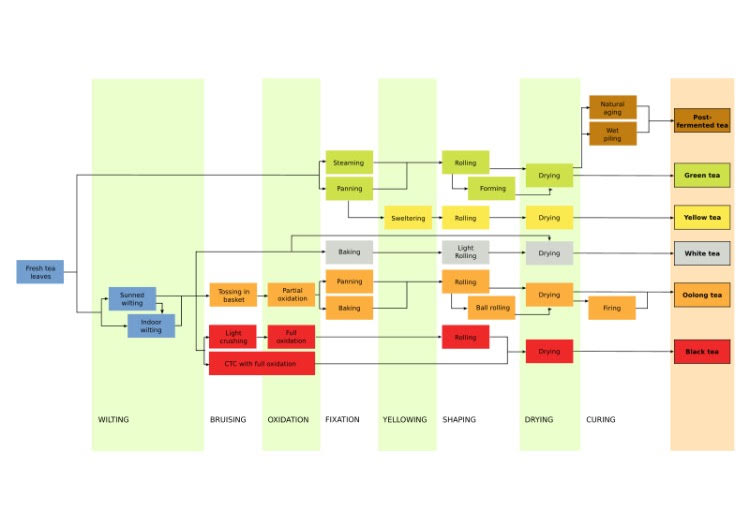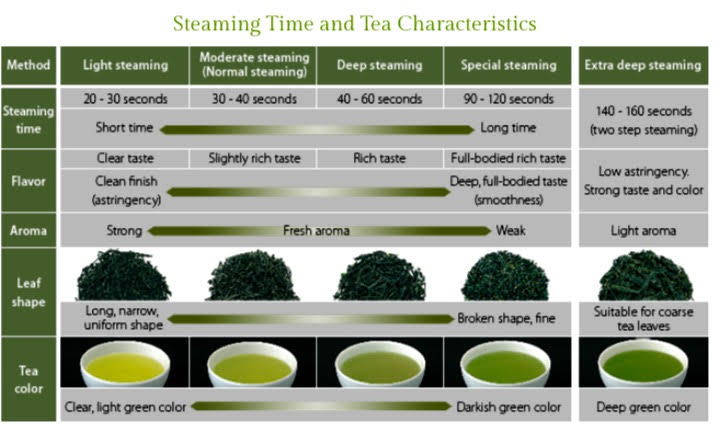
Green Tea
Soon after green tea leaves are picked in the field, they undergo their first phase of processing into what is called "crude tea" (crude tea manufacturing process). From the time raw tea leaves are picked they begin to oxidize and ferment. Crude tea refers to tea leaves that have had the action of oxidizing enzymes halted, fermentation prevented, had their moisture content reduced somewhat and processed into a state able to withstand storage. Subsequently, crude tea undergoes secondary processing whereby it is made into a finished product. The tea may then be sold as tea leaves or become the ingredients for beverage products.
To halt the oxidizing and fermentation action of enzymes on the leaves, preserve their green color and remove the "grassy" odor, the tea leaves are steamed using non-pressurized steam. The length of the steaming process is said to be a key determinant in the tea's flavor, aroma and color.
The steaming process has a significant effect on the Sencha's color and quality. The longer the steaming time, the more easily the tea leaves' cellular membrane breaks down during later processing. This in turn leads to cloudiness in the tea's color. However, longer-steamed leaves have a brighter luster while astringency and fragrance is reduced.
Cooling
If the steamed tea leaves are left at high temperature, they will lose their bright color and their flavor and aroma will be spoiled. For these reasons, to preserve the tea's luster and color as well as flavor and aroma, air is blown over the steamed leaves to rapidly cool them to normal room temperature.
Pressing
To enhance luster, color, flavor and aroma, and shorten the first rolling stage, the leaves are pressed while being exposed to dry, hot air from a fan to remove moisture. (This process removes steam dew from the leaves' surface and increases the drying effect.)
First rolling
To soften the leaves and lower the internal moisture content, hot, dry air is blown over the leaves while applying pressure and appropriate friction and compression.
Rolling and twisting
The leaves are pressed in a bundle without applying heat to break up their structure and make it easier for the components of the tea leaves to be released when it is made into tea. This process also compensates for any lack of pressing during the first rolling process and moisture content is made uniform.
Second rolling
Since the tea leaves wither after rolling and twisting and are still relatively high in moisture and uneven in size and shape, they are rolled while having hot, dry air blown on them. They are then dried and disentangled ready for final rolling.
Final rolling
To give the tea leaves their characteristic needle shape, they are rolled in one direction only, similar to the action of manual rolling, while further reducing moisture content.
Drying
The leaves have a moisture content of approximately 10-13% after final rolling, and this is reduced to 5% with hot-air drying. This allows long-term storage and further draws out their distinctive aroma.
Small-Scale Handcrafted Green Tea Processing by Assamica Agro
As a responsible
small-scale organic
green tea manufacturer in Assam, India, Assamica Agro
carries out every step of its green tea production process with
great care and handles all parts of green tea production by hand —
from hand-picking to hand-rolling, hand-shaping and hand-drying.
This process is extremely time-consuming and work-intensive, but it
yields a superior natural loose leaf green
tea.
Conventional machine
processing of green tea leaves typically takes approximately three
hours, whereas hand processing, which consists of rolling and
heating the leaves completely by hand, can take as long as 10 hours
to complete. However, because of Assamica Agro's dedication to
producing a superior and one of the best loose leaf green tea in
India, the company is fully committed to the handcrafted
green tea manufacturing process.
Assamica Agro grows its
green tea using purely natural, organic agricultural
methods and then goes on to manufacture a
top-quality organic
Indian green tea using the same level of care
throughout its natural green tea production process.
